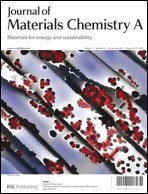Here, we report the synthesis and characterization of original 3,4-ethylenedioxypyrrole derivatives bearing two fluorinated tails (F-butyl: EDOP(F4)2 and F-hexyl: EDOP(F6)2). These monomers are used for the elaboration of superoleophobic surfaces by electrodeposition of conducting polymers. Cyclic voltammetry experiments show high steric hindrances during the electropolymerization due to the presence of the two fluorinated chains. Using a constant potential as deposition method, superhydrophobic and oleophobic surfaces are obtained (θhexadecane = 110.1° and 89.3° for PEDOP(F6)2 and PEDOP(F4)2, respectively). To improve the surface oleophobicity, various deposition methods were used. Superoleophobic surfaces with θhexadecane ≈ 140° are obtained with PEDOP(F6)2 using galvanostatic deposition (0.5 mA cm−2) and pulse potentiostatic deposition (tp/tr: 9 s/5 s). The superoleophobic properties are in part due to the presence of both surface microstructures and nanoporosities. In order to determine the influence of the intrinsic oleophobicity and surface structuration on the static contact angle of various probe liquids, from octane (γLV = 21.6 mN m−1) to water (γLV = 72.8 mN m−1), smooth surfaces were prepared. Here, surprisingly, a very important increase in surface oleophobicity is observed for all the tested probe liquids even if the contact angle of the smooth surface is much lower than 90° (e.g.: for octane, an increase from 57.4 to 107.0 was observed after surface structuration, for the best surface). This is in total contradiction with the Wenzel theory but can be explained by the presence of re-entrant structures, as described in the literature. This work confirms the importance of surface nanoporosities for the repellency of low surface tension liquids such as oils.

You have access to this article
 Please wait while we load your content...
Something went wrong. Try again?
Please wait while we load your content...
Something went wrong. Try again?


 Please wait while we load your content...
Please wait while we load your content...